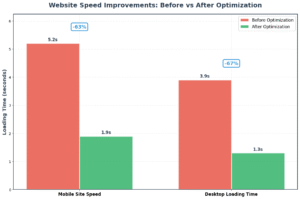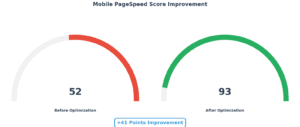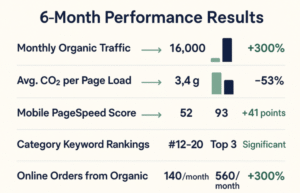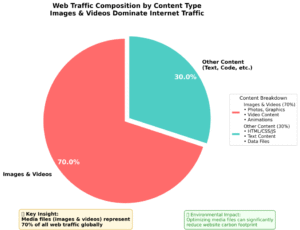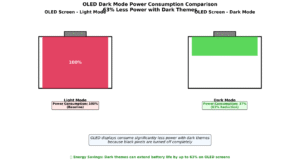Tag: green seo
Case Study: How We Grew a Hong Kong FMCG E-commerce Brand’s Traffic by 300% with Green SEO
Aug 15, 2025 | 3 Min Read

Client Overview
Business Type: E-commerce store specializing in premium bottled teas and healthy beverages
Industry: FMCG (Fast-Moving Consumer Goods) – Food & Beverage
Market: Hong Kong & Macau
The Challenge
Our client, a well-established Hong Kong beverage brand, faced a significant digital transformation challenge. Despite having strong offline retail distribution across major supermarket chains and convenience stores in Hong Kong and Macau, their online presence was virtually non-existent.
The brand’s e-commerce website suffered from multiple critical issues:
- Poor search visibility:The site ranked poorly for both branded keywords and essential category terms
- Technical performance issues:Slow loading speeds that frustrated potential customers
- High carbon footprint:Heavy media content and inefficient hosting created environmental concerns
- Missed opportunities: Low organic traffic meant they were losing potential sales to competitors
This disconnect between their strong offline presence and weak digital performance was particularly problematic in a post-pandemic market where Hong Kong consumers increasingly turned to online shopping for everyday essentials.
Strategic Objectives
Our comprehensive Green SEO strategy focused on three primary objectives:
- Drive Revenue Growth:Increase organic e-commerce traffic and convert visitors into paying customers
- Environmental Alignment:Reduce website carbon emissions to support the brand’s sustainability positioning in the competitive FMCG market
- Market Capture:Dominate search demand for relevant FMCG category keywords in the Hong Kong market
Our Revolutionary Green SEO Approach
Phase 1: Carbon & Technical Audit
We began with a comprehensive environmental and technical assessment of the existing website infrastructure:
Carbon Footprint Analysis:
- Initial measurement revealed 3.4g CO₂ per page load—significantly above sustainable benchmarks (ideal: <1.8g CO₂)
- Identified major emission sources: uncompressed product images, redundant JavaScript libraries, and energy-intensive hosting
Technical Performance Assessment:
- Mobile site speed: 5.2 seconds (well above Google’s recommended 3-second threshold)
- Desktop loading time: 3.9 seconds
- Multiple render-blocking resources affecting user experience
- Outdated hosting infrastructure lacking optimization
Phase 2: Sustainable Site Optimization
Green Infrastructure Migration:
Transitioned to renewable energy-powered hosting with certified green credentials
Implemented Content Delivery Network (CDN) with global edge locations to reduce data transfer distances
Performance Optimization:
- Image Optimization: Compressed product images using next-generation WebP format, reducing file sizes by an average of 67%
- Lazy Loading Implementation: Deployed progressive image loading to reduce initial page weight
- Code Optimization: Minified CSS, JavaScript, and HTML, eliminating unused code libraries
- Results: Overall page weight reduction of 47%
Speed Improvements:
- Mobile site speed: 5.2s → 1.9s (63% improvement)
- Desktop loading time: 3.9s → 1.3s (67% improvement)
- Mobile PageSpeed Score: 52 → 93 (+41 points)
Phase 3: FMCG-Focused SEO Content Strategy
Category Landing Pages: We developed targeted landing pages optimized for high-commercial-intent keywords:
- “Low sugar iced tea Hong Kong”
- “Organic bottled drinks Hong Kong”
- “Premium tea brands Hong Kong”
- “Healthy beverages delivery HK”
Product Page Enhancement:
- Added comprehensive FAQ sections addressing common customer concerns
- Implemented structured data markup for rich snippets
- Optimized product descriptions with location-specific keywords
Content Marketing: Published authoritative blog content linking beverages to Hong Kong lifestyle trends:
- “Best Summer Drinks for Hong Kong’s Humid Climate”
- “Sustainable Packaging Trends in Hong Kong FMCG”
- “Office Wellness: Healthy Beverage Choices for Hong Kong Professionals”
Phase 4: Green Link-Building & PR Strategy
Innovative Green Link Assessment: We utilized our proprietary GreenSEO tool to identify backlink opportunities based on sustainability metrics:
- Green Score: Measured target websites’ carbon efficiency and renewable energy usage
- ELS (Eco Linked Score): Our composite metric combining Green Score, Link Trust Score, and Link Relevance Score
- Sustainable Partner Selection: Prioritized collaborations with environmentally conscious Hong Kong lifestyle blogs, sustainable living websites, and eco-friendly business directories
Strategic Partnerships:
- Collaborated with Hong Kong environmental organizations
- Secured features in sustainable lifestyle publications
- Participated in green business directories and certifications
Key Strategic Takeaways
1. Values Alignment Drives Customer Acquisition
The Green SEO approach perfectly aligned with the brand’s sustainability values, attracting environmentally conscious Hong Kong consumers who prioritize eco-friendly purchasing decisions. This values-based marketing approach resulted in higher customer loyalty and increased average order values.
2. Local + Category SEO Maximizes FMCG Success
The combination of FMCG category keywords with precise Hong Kong location targeting proved highly effective in capturing high-commercial-intent traffic. Local consumers searching for specific beverage categories found our client’s products at the exact moment of purchase consideration.
3. Technical Optimization Drives Both Rankings and Conversions
The comprehensive technical improvements didn’t just boost search rankings—they created a superior user experience that significantly improved conversion rates and customer satisfaction.
4. Sustainable Practices Offer Competitive Advantage
In Hong Kong’s competitive FMCG market, the commitment to environmental responsibility became a key differentiator, attracting press coverage and customer loyalty that traditional SEO approaches couldn’t achieve.
Conclusion
For this Hong Kong FMCG e-commerce brand, our innovative Green SEO approach delivered extraordinary results across all key performance indicators:
- Revenue Growth: 300% increase in organic traffic and online orders
- Environmental Impact: 53% reduction in website carbon footprint
- Market Position: Established category authority in competitive Hong Kong beverage market
- Brand Trust: Enhanced reputation through authentic sustainability commitment
This case study demonstrates that Green SEO isn’t just an environmental initiative—it’s a powerful business strategy that delivers measurable growth while building long-term brand trust and market authority.
The success of this campaign proves that sustainable digital marketing practices can drive significant business results while supporting broader environmental goals, creating a win-win scenario for businesses, customers, and the planet.
If you’d like to explore how Green SEO strategies can boost your brand’s growth, feel free to get in touch with us here.
Note:
The statistics in this case study are indicators because of data security and privacy protection
How to Audit Your Website for Eco-Friendly SEO (2025 Guide)
Jul 29, 2025 | 3 Min Read

As digital activities account for 4% of global greenhouse gas emissions—equivalent to the aviation industry—eco-friendly SEO has become essential for responsible businesses1. Eco-friendly SEO combines traditional search optimization with sustainable web practices, reducing your website’s carbon footprint while improving performance and user experience.
1.Technical SEO Audit: Building Green Foundations
Begin by evaluating your web hosting provider’s environmental impact. The Green Web Foundation reports that a significant portion of the internet still relies on fossil fuels, but an increasing number of providers are transitioning to renewable energy sources. SiteGround powers its infrastructure with 100% renewable energy through Google Cloud, ensuring carbon-neutral hosting2. Google’s Core Web Vitals directly correlate with energy efficiency—faster sites consume less energy per user interaction3.
Code Optimization Audit your website’s technical efficiency:
- Minimize HTTP requests by combining CSS/JS files
- Compress images using WebP format (reduces file sizes by 25-35%)
- Enable GZIP compression to reduce data transfer
- Remove unused plugins and code bloat
2.Content Audit: Quality Over Quantity
Focus on creating high-value, evergreen content that serves users long-term rather than producing frequent, low-value posts. The UN Environment Programme emphasizes that sustainable digital practices include reducing unnecessary content creation4.
Audit existing content to:
- Consolidate similar pages
- Update outdated information instead of creating new pages
- Optimize content for featured snippets to reduce user search time
3.UX Audit: Energy-Efficient Design
Digital sustainability begins with user-centric design. Research shows that energy-efficient UX practices not only improve performance but also significantly reduce a website’s carbon footprint. Sustainable design principles, such as passive solar design and efficient HVAC systems, can reduce a building’s energy consumption by 50% or more, resulting in lower operational costs and a smaller environmental footprint:
- Use dark mode options (OLED screens consume 63% less power with dark themes)
- Optimize images and videos—they account for 70% of web traffic
- Implement lazy loading for below-the-fold content
- Choose system fonts over custom web fonts
4.Tracking and Measurement: Monitor Your Impact
Quantifying your website’s carbon footprint is the first step toward meaningful reductions. Digital emissions are often overlooked despite the internet’s global carbon output rivaling aviation emissions. You can use these tools to measure your website’s environmental impact:
- Website Carbon Calculator: Measures CO₂ per page visit
- Ecograder: Comprehensive sustainability scoring
- Google PageSpeed Insights: Correlates performance with energy efficiency
The average website produces 0.8g CO₂ per page view. A site with 10,000 monthly visitors generates 102kg CO₂ annually—equivalent to a 450km car journey6.
Conclusion: Take Action Today
Eco-friendly SEO isn’t just about environmental responsibility—it’s smart business. Sustainable websites typically load 2-3x faster, rank higher in search results, and provide better user experiences.
Start your eco-friendly SEO audit today:
Check your hosting provider’s renewable energy usage
Run a website carbon calculator assessment
Optimize your three highest-traffic pages
Set monthly carbon footprint reduction goals
Want to see what Green SEO can do for your brand? Drop us a message here — we’d love to hear from you.
References:
2.SiteGround. (n.d.). Green Web Hosting and SiteGround’s Commitment to Sustainability. Retrieved from
3.Google (2024). “Core Web Vitals and Performance Metrics.”
4.United Nations Environment Programme (2023). “Digitalization for Sustainability.”
6.HTTP Archive (2024). “Web Almanac 2024 – Sustainability Chapter.”



